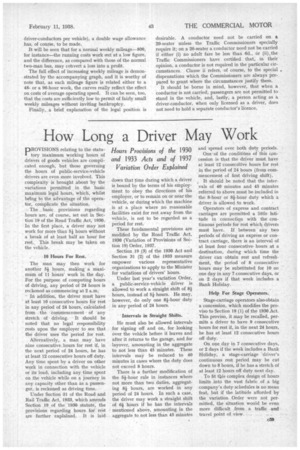One-man Buses May Turn Losses Into Profits
Page 108

Page 109

If you've noticed an error in this article please click here to report it so we can fix it.
expenses, so that this side of the question must be examined closely. In this connection The Commercial Motor Tables of Operating Costs will be found most useful in providing a basis for comparison with normal
0 100 2120 300 400 500 630 700 ' 800 900 1000 1100 1203 1300 1400 1500 MILES PER WEEK
ALTHOUGH there are many one-man buses in service throughout the country, especially in rural districts, the advantages of this type of vehicle are such that a proper understanding of them is essential for operators who are in any doubt about their usefulness.
In the first place, there is a wide selection of vehicles available, and in recent years there have been developments that have eased the work of the driver-conductor. The ticket-issuing machine, for instance, is invaluable as a time-saver. . Door-operating mechanism has been improved, the latest in this line being the pneumatic type of control, with which it is necessary only to press a button to open or close the door.
When Only One-man Buses Pay.
On certain routes, traffic is so light that the one-man bus is often the only means for making services pay their way. This, of course, is the obvious case for its use, but there are several others which may not be so apparent. At the present time, much development is taking place in the way of new housing estates, and here there are often opportunities for the opening of new bus routes, as well as for the extension of existing ones.
What could be better for this purpose than the oneman bus? A 20-seater or 26-seater of this type would ensure a minimum of expense, so that if the venture of testing a route did not come up to expectations, the loss would be minimized, whilst, if it were successful, the way would have been paved for the introduction of larger vehicles, if the traffic demanded them.
Ideal conditions are to be found for the one-man bus when the bulk of the traffic originates at the terminals of the route.
As the cost per mile is relatively low, it is frequently advantageous to test various headways. It is well known that extra facilities bring extra traffic and an increasedfrequency of service may be found to be more remunerative. Similarly, this type of vehicle is well suited for the working of late-night services from dances, theatres, etc. This is comparatively irregular traffic, so that the cost must be kept as low as possible, but on services after normal hours a minimum fare of, say, 6d. is often charged, and, under these conditions, the one-man bus stands a good chance of showing a handsome return.
Everything depends, however, on the working running costs. We must assume that only stage-carriage operation is involved,' so that the size of vehicle is restricted to a maximum of 26 seats : stage carriages of greater capacity must carry a conductor. Consequently, consideration must be given to the operation of 26-seaters and 20-seaters, both of which are included in the accompanying cost table.
What it Costs to Run.
This table shows the running costs, standing charges and, total operating costs per mile for various weekly mileages with both single and double-shift working for each size of vehicle. The figures differ from those in The Commercial Motor Tables only in respect of an adjustment of the price of petrol (which has been reckoned at is. 6d. per gallon) and an alteration in the wages allowance. The latter item has been based on the reasonable rate of is. 3d. an hour for a man an a 20-seater, and is. 4d. an hour on a 26-seater. For double-shift working, or a 96-hour week (implying two
driver-conductors per vehicle), a double wage allowance has, of course, to be made.
It will be seen that for a normal weekly mileage-800, for instance—the running costs work out at a low figure, and the difference, as compared with those of the normal two-man bus, may convert a loss into a profit.
The full effect of increasing weekly mileage is demonstrated by the accompanying graph, and it is worthy of note that, as each mileage figure is related either to a 48or a 96-hour week, the curves really reflect the effect on costs of average operating speed. It can be seen, too, that the costs are sufficiently low to permit of fairly small weekly mileages without inviting bankruptcy.
Finally.. a brief explanation of the legal position is
desirable. A conductor need not be carried on a 20-seater unless the Traffic Commissioners specially require it; on a 26-seater a conductor need not be carried if either (i) no adult fare be less than 641., or (ii)the Traffic Commissioners have certified that, in their opinion, a conductor is not required in the particular circumstances. Clause ii refers, of course, to the special dispensations which the Commissioners are always prepared to grant where the circumstances justify them.
It should be borne in mind, however, that when a conductor is not carried, passengers are not permitted to stand in the vehicle, and, lastly, a person acting as a driver-conductor, when only licensed as a driver, does not need to hold a separate conductor's licence.




























































































































































